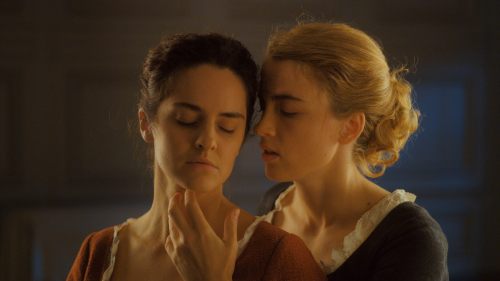Not Another Teen Movie - Desire In Celine Sciamma’s WATER LILIES
Portrait of a Lady on Fire is finally here. Get your tickets now!
A recent image surfaced online of Celine Sciamma and Bong Joon-ho, on Oscar night, embracing. It’s at the Parasite Oscar party. Bong’s face is alight, beaming, while he and Sciamma clutch the Oscar between them. It’s a powerful image of solidarity - of Bong Joon-ho, who made history that fateful night, joining with Sciamma, whose film Portrait of a Lady on Fire is maybe the only film that could have rightfully challenged Parasite for the title of best international film of 2019. What draws the eye in the picture is Sciamma’s face in an inscrutable mix of emotions - joy, elation, perhaps some melancholy at Portrait’s complete Oscar shut-out. It's captivating in the way most of Sciamma’s work is captivating - moments, all-too-brief, of sublimity within worlds that often work to snatch them away.
It is this that defines Celine Sciamma’s exquisite, masterfully wrought Portrait of a Lady on Fire, but it can also be traced back to her debut feature, Water Lilies. Indeed, the shared bloodline of the two films, separated by more than a decade, is profound. Portrait is a film defined by its emotional maturity. Restraint is the name of the game - from the controlled, painterly cinematography to the intricate connectedness of the two leads, who burgeoning romance is captured almost entirely through stolen glances and hidden meaning resting beneath the surface of their conversations. Perhaps most noticeable in Portrait is the sweltering, almost claustrophobic silence that permeates much of the runtime - so much so that moments of sound, such as a group of women singing on a beach, or a shattering, climactic performance of Vivaldi, land like hammer blows.
By contrast, Sciamma’s Water Lilies is awash in the chaotic noise of teenagedom, beginning as it does in the echoey expanse of an indoor pool, where a synchronised swimming team performs. From there, Sciamma charts the messy sexual awakenings of three girls, the quiet, stormy Marie (Pauline Acquart), anxious older sister Anne (Louise Blachère), and free-spirited Floriane (Portrait’s Adele Haenel) whose infectious popularity holds the other two in her thrall. Marie finds herself drawn helplessly into the world of Floriane, who is at once adored and branded as a ‘slut’, shunned by the community of young swimmers for her presumed experience with older men. Whether it’s love, lust, or some obsession built from an as yet unformed identity - or a blending of the three - Marie finds herself at the whim of Floriane, the extent of whose knowledge of the powerful hold she has over the other girl is left fairly ambiguous. Meanwhile, Anne stumbles upon sexual desire largely by accident, her story of seeking out a male lover parallelling and pirouetting with Marie’s in ways that could be an afterthought in the hands of a less assured filmmaker.
Like many of Sciamma’s films, figures of authority - parental figures, men in general - are absent in Water Lilies as they are in Portrait (in which Sciamma creates a kind of grim gag from the absence of men, who all but abandon the women at the outset of the film and arrive near the end to symbolically rob the romantic bliss that has grown between the two women). As a feminist filmmaker, Sciamma has little time for restrictive old world power structures, though she situates her stories within their architecture. Floriane is, in fact, a virgin, though she plays the part of the promiscuous teen as both a defense mechanism and for the occasional thrills it provides. In a pivotal sequence, Floriane unpacks the constant attention she receives from predatory older men to Marie, with whom she has skirted the edge of romantic partnership. The implication of this male attention is the clouding of her own understanding of her sexuality as a lesbian. This is made further clear in a scene in which Floriane discusses eating bananas - an age-old phallic symbol sure to catch the eye of men in the surrounding area - with one of the other swimmers:
Here, two things are immediately notable - the first being Haenel’s ability as an actress. It’s already pronounced throughout Water Lilies, as compulsively watchable for a viewer as her character is an object of compulsion for Marie, as she presents both a snappy, dismissive exterior and just a hint of vulnerability beneath. The other is Sciamma’s skill as a director - even here in her debut, she eschews excess or over-indulgence, prizes the intensity of the emotions between the characters. The only movement in the sequence is a quick whip-pan over to Marie, whose watchful solitude becomes useful in that very moment as a tool for Floriane to wield, to allow her to sneak out with young men under the guise of hanging out with Marie.
Water Lilies is a teen coming-of-age drama, certainly, but it is not a teen movie - indeed, it possesses the distance and emotional maturity of an older woman looking back on an earlier, more impulsive period of her life, before emotional wounds scarred over. This is clearest in the film’s ending - where other stories that prize the teenage perspective might allow its lovers to come together in a moment of triumph, Sciamma concludes Water Lilies on a devastating ellipsis, as all three girls come away without catharsis and with a lot more emotional baggage than they began with. Teenagedom is not a period of endings, not really - it is where so much of the foundation of our emotional identity is lain down. How many of us, after all, maintain all the friendships, feuds and love affairs of those years? All three of the girls find the walls of youthful innocence kicked in, in rude, often unpleasant ways. Each experience their first inklings of desire, which provide exhilarating glimpses of adulthood while simultaneously chaining them to the various emotional traumas desire can wreak. In Sciamma’s later, most sublime film, that same desire would both deny the film’s lovers a lifelong romantic entanglement and also provide them the sustenance of love, to push them through the strictures of 18th Century Europe that conspire to keep them apart. In Water Lilies, as in Portrait, desire is a paradox - at once a prison and a liberator.



